
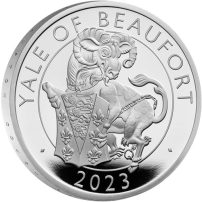
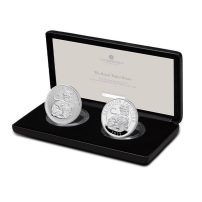
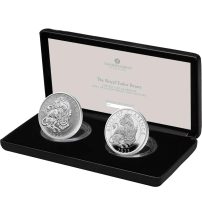
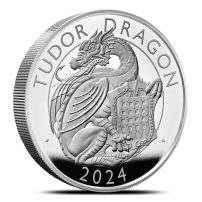
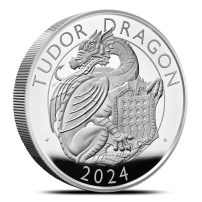
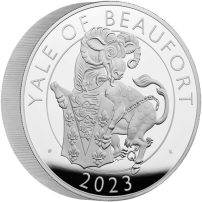
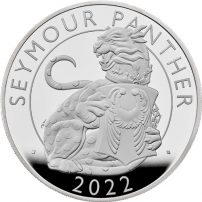
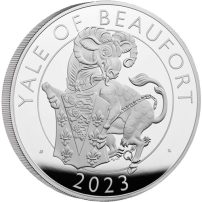
Following the success of the Queen’s Beasts Series of gold and silver coins for sale, the Royal Mint is embarking on a new collection starting in 2021. While the Queen’s Beasts Series focused on the heraldic creatures of the monarchy that have evolved and changed over more than 800 years, the Tudor Beasts Series is a more focused collection. Celebrating the heraldic beasts of the House of Tudor, the new Tudor Beasts Series is sure to excite bullion investors, collectors, and British history enthusiasts.
The Tudor Beasts Silver Series consists of several proof options, as well as 2 oz silver BU and 10 oz silver BU coins. All of the proof coins are packaged individually inside of Royal Mint presentation boxes with a themed shipper and Certificate of Authenticity available. The 1 Kilo silver coin has a wooden presentation box, while all other weights in proof silver have a black display.
For the BU coins, the 10 oz silver coin is available in plastic capsules or in boxes of 15 coins. The 2 oz silver coin is packaged in protective flips, acrylic tubes of 10 coins, or boxes of 200 coins.
For the first release of the series, the Royal Mint features the Seymour Panther. This heraldic creature was gifted to Jane Seymour, third wife of King Henry VIII, upon their marriage. Henry VIII had recently had his second wife, Anne Boleyn, executed and was working to destroy or replace her badges and arms when he married Jane Seymour. He gifted her an altered version of Anne’s leopard. The Seymour Panther features a spotted panther with flames coming from its mouth and ears. The panther supports a shield with the Seymour Wings emblazoned upon it, with the joined wings arranged with the wingtips pointing downward.
In the second issue of the Tudor Beasts Series, the Royal Mint features the most prominent and powerful heraldic beast in the history of England. Here, the Lion of England is shown wearing its traditional Imperial Crown as it is seated behind a shield. That shield has the impaled arms of King Henry VIII and Jane Seymour. The shield depicts the Royal Arms of Henry VIII’s reign with the personal emblem of Jane Seymour, his third wife.
For the third issue of the series overall, and second in the BU Series, the Yale of Beaufort appears on the coins of the Tudor Beasts Series. The Yale is named for the powerful Beaufort family and came to the heraldry of the crown through King Henry VII. However, it was his son, King Henry VIII, who prominently used the Yale. Henry VIII chose the Yale to support the Arms of Jane Seymour to establish her authority as his new wife. The design shows the Yale supporting a shield with the Arms of Jane Seymour.
The Bull of Clarence holds a significant place in English heraldry. It is a symbol often associated with the House of York, one of the rival factions during the Wars of the Roses in 15th-century England. The Bull of Clarence represents strength, power, and resilience. It takes its name from the title “Duke of Clarence,” which was held by several members of the York family, including George Plantagenet, brother of King Edward IV. The bull is depicted as a rampant bull, standing on its hind legs, with its front legs raised in a striking pose. Its presence in English heraldry serves as a reminder of the turbulent times of the Wars of the Roses and the dynastic struggle for the English throne.
The first 2024-dated coin in the series captures the Seymour Unicorn. The unicorn is traditionally associated with Scotland as a member of the United Kingdom, but did not become a fixture of English heraldry until the Union of Scotland and England with the reign of King James I. However, Henry VIII gifted the unicorn to his third wife, Jane Seymour, as the unicorn has long been viewed as a symbol of purity, grace, and nobility.
The Tudor Beasts Series debuted late in the reign of Queen Elizabeth II. The first four issues featured a bust of Queen Elizabeth II, while all issues as of the fifth design feature a portrait of King Charles III. These designs include:
Please note that the Royal Mint has released the initial designs in this series in a different order across the BU and Proof collections. The proof series has the following order:
Meanwhile, the BU series has the following order, so far:
As for the total list of planned designs, you will find the following 10 beasts issued in this series from the Royal Mint:
The House of Tudor was formed by Henry Tudor, head of the House of Lancaster, at the end of the Wars of the Roses. Following his victory over King Richard III of the House of York at the Battle of Bosworth, Henry moved to legitimize his claim to the throne by marrying Elizabeth of York. He founded the House of Tudor in 1485 which would go on to control the throne of England until 1603.
If you have any questions about the new Tudor Beasts Series, please don’t hesitate to ask. JM Bullion customer service is available at 800-276-6508, online using our live chat, and via our email address. You can visit our Payment Methods page to get quick, simple answers to your common questions regarding the forms of payment we accept.